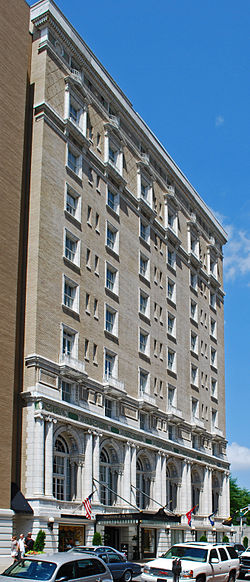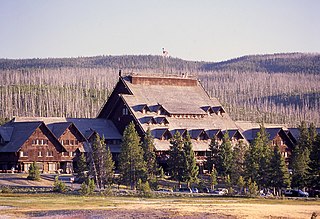
The Old Faithful Inn is a hotel in the western United States with a view of the Old Faithful Geyser, located in Yellowstone National Park, Wyoming. The Inn has a multi-story log lobby, flanked by long frame wings containing guest rooms. In the western portion of the park, it sits at an approximate elevation of 7,350 feet (2,240 m) above sea level.

The Hermitage is a historical museum located in Davidson County, Tennessee, United States, 10 miles (16 km) east of downtown Nashville. The 1,000-acre (400 ha)+ site was owned by Andrew Jackson, the seventh president of the United States, from 1804 until his death at the Hermitage in 1845. It also serves as his final resting place. Jackson lived at the property intermittently until he retired from public life in 1837.

Ryman Auditorium is a historic 2,362-seat live-performance venue located at 116 Rep. John Lewis Way North, in the downtown core of Nashville, Tennessee, United States. A Rock & Roll Hall of Fame Landmark, National Historic Landmark, and the former home of the Grand Ole Opry, it is one of the most influential and revered concert halls in the world. It is best known as the home of the Grand Ole Opry from 1943 to 1974. It is owned and operated by Ryman Hospitality Properties, Inc. Ryman Auditorium was listed on the National Register of Historic Places in 1971 and was later designated as a National Historic Landmark on June 25, 2001, for its pivotal role in the popularization of country music. A storied stage for Rock & Roll artists for decades, the Ryman was named a Rock & Roll Hall of Fame Landmark in 2022.

The Fox Theatre is a performing arts center located at 2211 Woodward Avenue in Downtown Detroit, Michigan, near the Grand Circus Park Historic District. Opened in 1928 as a flagship movie palace in the Fox Theatres chain, it was at over 5,000 seats the largest theater in the city. Designed by theater architect C. Howard Crane, it was listed on the National Register of Historic Places in 1985.

The Fairmont Hotel Macdonald, formerly and commonly known as the Hotel Macdonald, is a large historic luxury hotel in Edmonton, Alberta, Canada. Located along 100 Street NW, south of Jasper Avenue, the hotel is situated in the eastern end of downtown Edmonton, and overlooks the North Saskatchewan River. The 47.7-metre-high (156 ft) hotel building was designed by Ross and MacFarlene and contains eleven floors. The hotel is named for the first prime minister of Canada, Sir John A. Macdonald.

Nashville's Union Station is a former railroad terminal designed by Richard Montfort, chief engineer of the Louisville and Nashville Railroad (L&N), and built between 1898 and 1900 to serve the passengers of the eight railroads that provided passenger service to Nashville, Tennessee, at the time, but principally the L&N. Built just west of the downtown area, it was spanned by a viaduct adjacent to the station and positioned to the east and above a natural railroad cut, through which most of the tracks in the area were routed. The station was also used by streetcars prior to their discontinuance in Nashville in 1941.

The Blackstone Hotel is a historic 290-foot (88 m) 21-story hotel on the corner of Michigan Avenue and Balbo Drive in the Michigan Boulevard Historic District in the Loop community area of Chicago, Illinois. Built between 1908 and 1910, it is on the National Register of Historic Places. The Blackstone is famous for hosting celebrity guests, including numerous U.S. presidents, for which it was known as the "Hotel of Presidents" for much of the 20th century, and for contributing the term "smoke-filled room" to political parlance.

The Driskill, a Romanesque-style building completed in 1886, is the oldest operating hotel in Austin, Texas, United States, and one of the best-known hotels in Texas generally. The Driskill was conceived and built by Col. Jesse Driskill, a cattleman who spent his fortune constructing "the finest hotel south of St. Louis".

The Peabody Memphis is a historic luxury hotel in Downtown Memphis, Tennessee, opened in 1925. The hotel is known for the "Peabody Ducks" that live on the hotel rooftop and make daily treks to the lobby. The Peabody is a member of Historic Hotels of America, a program of the National Trust for Historic Preservation.

The Mayo Hotel is a historic hotel opened in 1925, located at 115 West 5th Street in downtown Tulsa, Oklahoma.
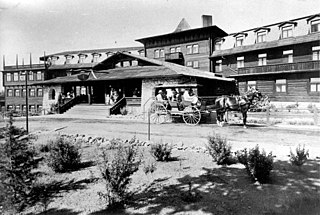
The El Tovar Hotel, also known simply as El Tovar, is a former Harvey House hotel situated directly on the south rim of the Grand Canyon in Arizona, United States.
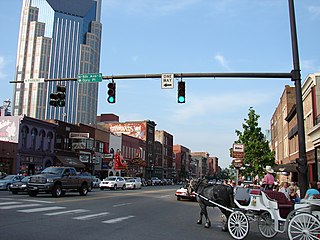
Broadway is a major thoroughfare in the downtown area in Nashville, Tennessee. It includes Lower Broadway, an entertainment district renowned for honky tonks and live country music.
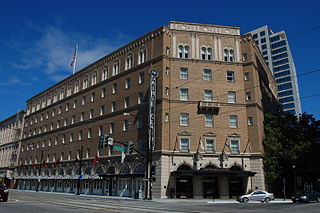
The Westin San Jose, housed in the historic Sainte Claire Hotel, is a six-story landmark hotel in Downtown San Jose, California, United States. Built in 1926, it is listed on the National Register of Historic Places and one of the city's most recognized architectural landmarks.

The Maxwell House Hotel was a major hotel in downtown Nashville. Because of its stature, seven US Presidents and other prominent guests stayed there over the years. It was built by Colonel John Overton Jr. and named for his wife, Harriet (Maxwell) Overton. The architect was Isaiah Rogers.

The Oregon Caves Chateau is a historic American hotel that opened in 1934. It is located in Oregon Caves National Monument in southern Oregon, near Cave Junction. The Chateau was designed and built by Gust Lium, a local contractor. Declared a National Historic Landmark in 1987, the Chateau building is architecturally significant because of its construction and design.

The Grand Canyon Lodge is a hotel and cabins complex at Bright Angel Point on the North Rim of the Grand Canyon. It was designed by Gilbert Stanley Underwood, who designed a number of other hotels in national parks for the Utah Parks Company and other concessioners. Built in 1927–28, the Grand Canyon Lodge resort complex consists of the Main Lodge building, 23 deluxe cabins, and 91 standard cabins, some of which were moved to the north rim campground in 1940. All guests are housed in cabins detached from the main lodge, which serves as a dining, concessions and service facility. Constructed of native Kaibab limestone and timber, the complex was designed to harmonize with its rocky and forested setting. The Grand Canyon Lodge complex is notable for its setting and rustic design, as well as its status as the only complete surviving lodge and cabin complex in the national parks.
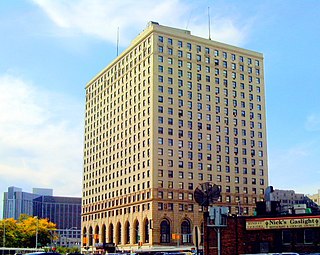
The Detroit-Leland Hotel is a historic hotel located at 400 Bagley Street in Downtown Detroit, Michigan. It is the oldest continuously operating hotel in downtown Detroit, and was listed on the National Register of Historic Places in 2005. The ballroom of the Detroit-Leland has hosted a nightclub, the City Club, since 1983. The hotel is now named The Leland and no longer rents to overnight guests.

The Blackstone Hotel is the tallest hotel in downtown Fort Worth, Texas, at 268 ft (82 m) tall. Located on the corner of Fifth and Main Streets, it is noted for its Art Deco design with terracotta ornamentation and setbacks on the top floors. The hotel was constructed in 1929 and operated for over 50 years before it sat vacant for nearly 20 years. The Blackstone Hotel guest list is full of notable people including Presidents of the United States: Harry S. Truman, Dwight D. Eisenhower, John F. Kennedy, Lyndon B. Johnson, and Richard M. Nixon. The hotel was also host for a few movie stars such as Bob Hope, Clark Gable, and Elvis Presley. It was added to the National Register of Historic Places on February 2, 1984. The building was restored in the late 1990s and is still in use today as the Courtyard Fort Worth Downtown/Blackstone, although it is still known as the "Blackstone Hotel" to those who live in or have ties to Fort Worth.
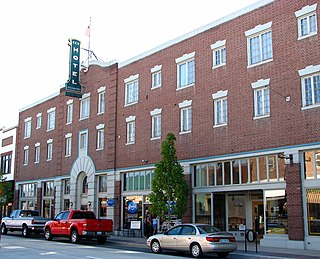
The New Redmond Hotel is a historic commercial hotel in Redmond, Oregon, United States. The hotel was built in 1928 after the original Redmond Hotel, was destroyed in a fire. It is a three-story Georgian-style brick masonry building located on 6th Street in downtown Redmond. It has been in continuous use as a commercial hotel since it first opened. Today, the New Redmond Hotel is a major landmark in downtown Redmond. Because of its importance to the history of Redmond, the New Redmond Hotel is listed on the National Register of Historic Places. On August 1, 2019, Soul Community Planet announced that after a two-year, $7 million renovation, The New Hotel Redmond by SCP opened in the Fall of 2019. The 41,000 square-foot, 49-room hotel, was redeveloped in partnership with the city of Redmond. The Rooftop, a 1,500 square-foot rooftop social garden, was added, opened in August. The redevelopment was made possible through a public-private partnership between the city of Redmond and the developer – a partnership managed by Alpha Wave Investors and RevOZ Capital. The city of Redmond, through its Redmond Urban Renewal Agency, provided a $3.53 million investment in the project.
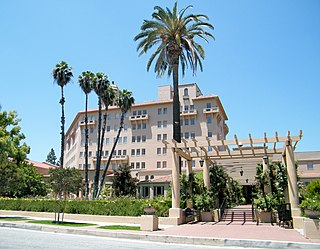
The Richard H. Chambers U.S. Court of Appeals is a historic building originally constructed as a Spanish Colonial Revival style resort known as the Vista del Arroyo Hotel and Bungalows located at Pasadena in Los Angeles County, California. During World War II, it served as the McCornack General Hospital, and was thereafter in use as a general-purpose federal government building for several decades. It now serves as a courthouse of the United States Court of Appeals for the Ninth Circuit.
